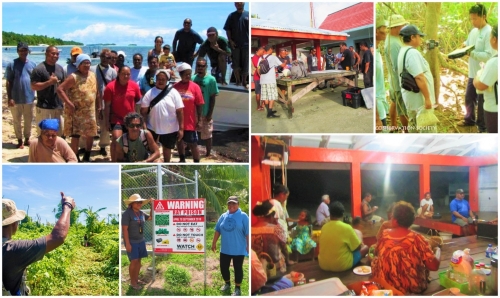
Aichi Biodiversity Target 9: By 2020, invasive alien species and pathways are identified and prioritized, priority species are controlled or eradicated, and measures are in place to manage pathways to prevent their introduction and establishment.
20 November 2018, Sharm El Sheikh - The eradication of rats and feral cats on Kayangel Atoll in Palau has helped bring about an increase in their megapode bird population, regrowth of local root crops and the employment of local community members to help sustain their conservation efforts.
Showcased at a special event at the 14th Conference of the Parties to the UN Convention on Biological Diversity (CBD COP14), Palau shared their invasive species story having undertaken five specific projects to restore their native island ecosystems.
“Of the five eradication activities we undertook, we were successful in four of these, which have brought about many positive differences,” said Ms Gwen Sisior, Senior Projects Manager in the Ministry of Natural Resources, Environment & Tourism in the Republic of Palau.
“And where we weren’t successful in eradicating, we are learning why and we’ll continue to keep trying.”
The Fanna Island rat eradication activities aimed to restore their native island ecosystem, yet was unsuccessful in doing so however the Helen Reef Rat Eradication Project successfully helped restore the seabird colonies, the Ngcherur Island Pig Eradication activity successfully helped restore their native island ecosystems as did the Kayangel Atoll rat and feral cat eradication.

Kayangel State is home to the biggest population of Micronesian megapode – an endangered bird on the IUCN Red List that triggered the rodent eradication project that was launched in 2009, distributing poison bait widely across the atoll.
In addition to this, feral cat trapping also took place as well as a pet cat and dog spay and neuter clinic.
“This has helped protect the bird population for which monitoring has shown a 68% increase of the Micronesian megapode since the rats were eradicated,” said Ms. Sisior.
“The local root crop stock was secured and yield has increased for crops that had long suffered damage. The risk of water-borne diseases was reduced which helped bring about a healthier environment for the residents.”
Aside from this there were also other positive effects from the rat eradication project in Kayangel State.
Full community ownership started to grow with Kayangel leaders and community understanding the need to protect more areas leading to a new terrestrial protected area. Island-wide management planning was actioned as well as a biosecurity plan and the nomination of marine and terrestrial sites to be included in the Palau Protected Areas Network, a system which provides sustainable funding for conservation.
“Prior to this there were no community members working in conservation, this project saw a complete turn-around in the understanding of good conservation practices. There are now six full time employees working in conservation with the Kayangel Protected Areas Network Authority,” said Ms. Sisior.
“Kayangel is very much taking charge of their own resources, with local rangers trained to manage the project. This ownership has also been enshrined in legislation by the community through the creation of the Kayangel Conservation Act of 2012, which protects their marine and terrestrial sites and formalised their ability to look after their resources. There have been so many benefits from this activity, we are very pleased.”
Palau also formed the Palau Invasive Verterbrate Removal Program with Island Conservation and various local, regional and international partners such as Palau Conservation Society, Palau Bureau of Agriculture, Micronesia Challenge Trust and BirdLife Pacific.
Palau presented at the “Beyond biodiversity: Scaling up invasive species eradications on islands” event at the CBD COP14 in Sharm El Sheikh, Egypt. The CBD COP14 is held from 17 to 29 November, 2018. – #CBDCOP14